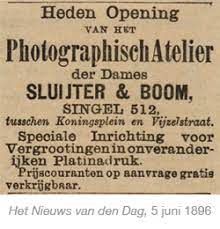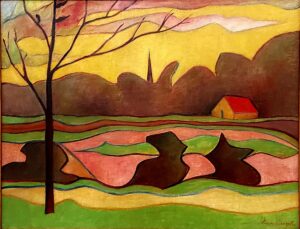Anna Sluijter (1866-1931) was a Dutch painter, illustrator and photographer. A strong woman who went her own way in her art.

Anna Sluijter
The Wood / Het Bos
Oil on canvas
Signed lower right,
ca. 1914
79,1 x 95,5 cm.
Life & work
Johanna Josina Helena (Anna) Sluijter was born in Amsterdam on 5th December 1866. Het father, Ernst W.G. Sluijter (1834-1920), was a bookkeeper, later an insurance broker. Her mother was Helena Witpen (1835-1920). We don’t know how she was educated in the art of painting or by whom; possibly she taught herself. Fact is that she already exhibited her work in Maastricht and Rotterdam, according to Klarenbeek (2012).
Around 1896 she spent a few months in Paris, like many of her fellow-artists, as Paris was then the centre of the artworld.
Anna was an active feminist. She was a member of the ‘Vereeniging voor Vrouwenkiesrecht’ (Association for Women’s Vote). She might have met  painter Charlotte Boom-Pothuis here. They must have acquired proficiency in the then new art of photography as in 1896 the openend their own photo studio in Amsterdam, Singel 512. They operated under the name of ‘Dames Sluijter & Boom’, and they were one of the first photo studio’s in Amsterdam run by women. One portrait of a man in a light jacket is known to have been made in their studio. Unfortunately they sold their equipement ten months later in 1897. The reason is not known; did they choose to go back to painting or did they go bankrupt?
painter Charlotte Boom-Pothuis here. They must have acquired proficiency in the then new art of photography as in 1896 the openend their own photo studio in Amsterdam, Singel 512. They operated under the name of ‘Dames Sluijter & Boom’, and they were one of the first photo studio’s in Amsterdam run by women. One portrait of a man in a light jacket is known to have been made in their studio. Unfortunately they sold their equipement ten months later in 1897. The reason is not known; did they choose to go back to painting or did they go bankrupt?
In 1897 Anna Sluijter left her parent’s house and started living on her own in Amsterdam. Strange enough she registered a ‘seamstress’ – this would not change into ‘painter’ until 1902. Het civil status was ‘unmarried’. Like many of her strong-willed female colleagues she must have chosen for her art instead of married life. In those days a married woman was totally dependent on her husband and was even considered ‘unable to act’.
In 1906 she had a son, Albert Sluijter who became quite a famous violinist. She raised him on her own and later often accompanied him on his travels to Dutch and foreign concert halls. Anna Sluijter must have been a very independent woman who lived an unconventional life, which was not easy in her days. She was an active fighter for women’s rights, equality and freedom.
As from 1917 she lived at several addresses in the Gooi region – Blaricum, Laren and Huizen, where she must have met the much younger abstract painter Lou Loeber. We can find the influence of her friend Loeber in Anna’s own paintings of landscapes. The colourful abstract style elements are typical in her paintings. This abstraction was ‘en vogue’ in these ‘modern’ times. She worked in her studio in Blaricum, where she held an exhibition of paintings and drawings (she was also an illustrator) in 1929.

Singer Museum, Laren.
Anna Sluijter was a member of the ‘Onafhankelijken’ (Independents), a jury-free painter’s association founded in 1912. Here she exhibited on a yearly basis.
In general, her work ws praised for its ‘pleasant colours’ and critic Luc Willink stated in 1923: “Her work is cold and sombre but the sadness is very beautiful.” Both Anna Sluijter and Lou Loeber wanted their art not for the ‘elite’ but wished to touch the soul of the beholder, according to Van der Stighelen (2010).
Anna Sluijters died in Laren on 7th December 1931, just after her 65th birthday. As so many of her female colleagues, after her death she and her work were forgotten. Until one of her paintings (Landscape with red path and row of trees) was auctioned in 1981. From then on she made a come-back, slowly but surely.

Anna Sluijter
Landscape with red path and row of trees
Oil on canvas
Signed lower right, ca. 1924
Singer Museum, Laren
Exhibitions
– from 1890: in Maastricht and Rotterdam
– from 1913: yearly at The Independents
– 1929: in The Sayer, Blaricum
– 2021-2022: several exhibitions in Singer Museum, Laren.
Her work is held by private collectors and by the Singer Museum in Laren.
Sources
– Groot, M. (2007). Vrouwen in de vormgeving in Nederland 1880-1940. Rotterdam,
– Klarenbeek, H. (2012). Penseelprinsessen & Broodschilderessen. Bussum.
– ‘Anna Sluijter’ in Magazine De kunst, jrg 24, 1931/1932, no 1235, 12-12-1931.
– Stighelen, K. van der. (2010). Vrouwenstreken. Tielt: uitg. Lannoo.
– Catalogue (2022). Vrouwelpalet 1900-1950. Zwolle: uitg. Waanders.
– City Archives of Amsterdam.
– RKD Ned. Institute of Art History, The Hague.